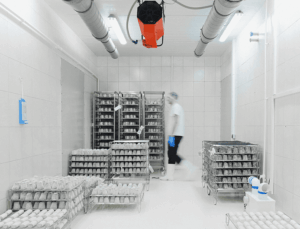What is a make-or-buy decision?
Make-or-buy (or build-or-buy) is the basic choice companies have between creating a product or service themselves (in-house production) or outsourcing it to a third party (external procurement).
If the company decides to buy, the next question is whether to commission a bespoke solution or to buy a ready-to-use product (e.g., an SDK) and adapt it as needed (as in a white-label solution).
What are the factors influencing the make-or-buy decision?
The main factor for the make-or-buy decision is the total cost of ownership (TCO). Companies compare the amount of money they would have to spend to produce something in-house to the price of purchasing it from an external supplier.
Make-or-buy decisions often come up in software development. At first glance, coding the desired features in-house is a convenient option: Flexibility, customization, cost-efficiency, and knowing the skillsets of the employees involved are important benefits of going with make.
But there are also disadvantages:
- Human resources: Employee migration can leave companies short of staff with the know-how to maintain the software, especially smaller businesses.
- Time: Developing a solution in-house can take years, whereas an SDK can often be integrated in less than a week.
- Resources: Internal concerns often have low priority. When capacity bottlenecks appear, in-house projects are frequently postponed.
- Know-how: Internal staff often lacks the knowledge required to implement specific software solutions. Ready-made software from specialized companies builds on expertise developed through years of experience.
- Maintenance: Updates, bug fixes, and enhancements must all be done internally.
- Costs: The initial development cost and the total cost of ownership are important considerations. Many factors need to be priced in, e.g., the risk of personnel fluctuation.
The benefits of using a software development kit
A software development kit (SDK) is a collection of components that makes it easier to develop specific features. With our Barcode Scanner SDK, Document Scanner SDK, and Data Capture SDK, these components include documentation, tools, libraries, and example projects. The main advantage is that the software package is ready for immediate use – yet also deeply customizable.
Advantages of our SDK include:
- Sophisticated features: We have optimized our scanning features over years while covering a variety of use cases for our customers. Our solutions handle billions of scans every year.
- Regular updates and new features: Our developers ensure that the SDK is state-of-the-art and runs flawlessly on new versions of iOS or Android. All software updates are covered by your license fee. If we add new features to the package you already booked, these are free of charge as well.
- Support: We provide a dedicated channel on Slack for every customer. If there is a problem with the Scanbot SDK, our developers are just a quick message away.
- Fixed pricing: The price of our SDK depends on the number of apps (or domains, in the case of our Web Barcode Scanner SDK), not on the number of users, scans or devices. The flat license fee lets you calculate your budget precisely and scale up your operations as much as you like.
- Easy integration: Thanks to our well-structured documentation, you can integrate our SDK seamlessly and in no time at all. The pre-configured user interface means that you can use the scanning features right away, with options for a customized UI in your branded design.
- User-friendliness: Our intuitive user interface ensures flawless scan results that do not require manual corrections. This guarantees a fast, smooth workflow.
Make or buy?
There are numerous advantages to using a third-party solution and integrating an SDK into your existing app. They also let you move fast: Developing new functionalities in-house can take years, which makes an SDK an appealing alternative. However, the right decision depends on the individual use case and the resources available to a company.



